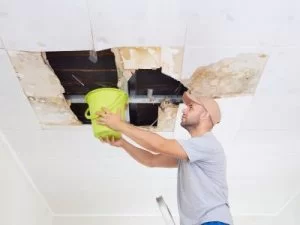When a stain is found on a ceiling, many homeowners may believe that this is a cosmetic issue. Stains and blemishes on walls and ceilings are unsightly and it is common for homeowners to want these stains to be covered up immediately. However, stains on ceilings don’t come out of nowhere. If there is a stain on your ceiling, there is a good chance that this stain is a water stain caused by a leak. Simply covering up the stain will only solve the problem cosmetically. You must address the issue that caused the leak and resulted in the stain, or you could end up with a much bigger problem.
Damage from a Water Leak
 Building materials that are commonly used in homes such as wood, insulation and drywall readily absorb water. This allows the water from a leak to spread through these materials very quickly and reach more areas of the home. The water stain on your ceiling may just be a small part of the damage; the water likely leaked from somewhere above the ceiling and traveled through the insulation and support beams before staining the wood or plaster surface of your ceiling.
Building materials that are commonly used in homes such as wood, insulation and drywall readily absorb water. This allows the water from a leak to spread through these materials very quickly and reach more areas of the home. The water stain on your ceiling may just be a small part of the damage; the water likely leaked from somewhere above the ceiling and traveled through the insulation and support beams before staining the wood or plaster surface of your ceiling.
Building materials that have absorbed too much water may become discolored, warped, and weakened which can result in major structural damage. Ignoring a leak above your ceiling can eventually weaken the materials enough for the ceiling to collapse. If there is water above your ceiling, there is also a risk of mold growth. Mold thrives in dark areas with excess moisture and the presence of the mold will not only increase the risk of damage, but also the risk of negative health effects caused by mold exposure.
Water stains on your ceiling require immediate attention because they are almost always a sign of more extensive water damage happening above the ceiling. You must uncover the source of the water leak that caused the stain and fix the leak before dealing with the stain itself. This guide explains the most common causes of water leaks that lead to water stains on the ceiling, how to find and stop the leak, and how to remove the stain from your ceiling.
Common Causes of Ceiling Water Stains
 It can be difficult to find the source of ceiling water damage because there are many potential sources. The following are the most common causes of water damage and stains on your ceiling:
It can be difficult to find the source of ceiling water damage because there are many potential sources. The following are the most common causes of water damage and stains on your ceiling:
- Gutters: Gutters are responsible for draining rainwater runoff from the roof of your home away from the home. When the gutters are clogged, water can end up pooling on the roof or overflowing from the gutters and running down the side of the house. If clogged gutters are the cause of the leak, clean out the gutters and check the gutter system and the surrounding areas of the roof for damage.
- Roof Damage: Roof damage caused by debris or general wear and tear can make it vulnerable to leaks. Check the area of your roof near the leak for damage to the shingles, flashings, roof deck, and fascia that could be causing a leak. It is usually best to have a roofing professional repair damage to your roof.
- Old or Damaged Caulk: If the leak is coming from an upstairs bathroom, old or damaged caulk may be the cause. Check the caulk around the toilet, bath and shower. If the caulk is old or damaged, reapply caulk to these areas to prevent leaking.
- Leaking Plumbing Fixtures: A leaking toilet, sink, or bathtub in an upstairs bathroom could be the cause of a leak, regardless of the condition of the caulk. If any of these plumbing fixtures are damaged, you should replace the fixtures or call a plumber to replace or repair them.
- Pipe Damage: Pipes can become damaged in many ways that can cause them to leak. Pipes may experience physical damage from an outside source, old pipes can become corroded and weak, and hard water can also cause damage to the pipe. If the leak is caused by a damaged pipe, it will have to be replaced immediately.
- Frozen Pipes: It is common for water within pipes in uninsulated areas of a home to freeze when the outside temperature drops below freezing. When this happens, the ice will expand and cause a blockage within the pipe that will eventually cause it to burst. Burst pipes also have to be replaced right away.
- Appliance Water Lines: These water lines that supply water to your refrigerator and other appliances are separate from the main plumbing pipes. Check the appliance water lines for a leak and either repair or replace the faulty parts.
Finding and Repairing the Leak
 As mentioned above, the stain on your ceiling is usually the least of your worries. Before you can even begin dealing with the water stain, you must find and repair the leak. Make sure you follow these steps to identify the source of the water damage:
As mentioned above, the stain on your ceiling is usually the least of your worries. Before you can even begin dealing with the water stain, you must find and repair the leak. Make sure you follow these steps to identify the source of the water damage:
- Find the leak: Start at the stain and look around the area to find the leak. However, the leak might not be in the exact same area as the stain. You might have to go inside your walls or above the ceiling to locate the leak.
- Identify the source: Once you find the leak, follow the leak to locate the source. If there is a bathroom above the stain, the leak could be from a plumbing fixture or worn out caulk. If the water is coming in through the roof, there could be roof damage or clogged gutters. Make sure you also check the pipes and water lines near the stain for leaks or damage. Determining the direction that the leak is moving will help you better identify the source.
- Consider the timing of the leak: The timing of the leak can help you identify its source. If the leak occurs after you take a shower or flush the toilet, the bathroom is the likely source. If the leak happens after it rains, there is likely a problem with the gutters or roof.
- Determine the quality of the water: The quality of the water can also help you find the source of the leak. You can tell the quality of the water from the look of the stain. If the stain is colorless and odor free, the source is likely a fresh water source such as a pipe or appliance line. If there is an odd color or odor to the stain, the leak may be from the roof or the bathroom.
Addressing the Water Damage and Stain
If you catch the leak right away, you may be fortunate enough to have the ceiling stain as the only resulting damage. In this case, you can proceed with the following tips to remove the stain from the ceiling. You should only address the stain after you have discovered and repaired the source of the water. If there is significant water damage beyond just the stain, you must call a professional such as ServiceMaster Restoration and Cleaning for water damage restoration.
- Clean the stain: The water stain may consist of dirt and mildew so it must be cleaned with a mild solution containing bleach. You can make this solution by mixing one cup of bleach with three cups of warm water. Set an old towel or cloth under the spot of the ceiling on the floor to protect it from the bleach. Dip a sponge in the bleach solution and use a ladder to reach and wipe down the stain. Make sure you are wearing gloves and goggles to protect yourself from the bleach. Use a spray bottle of clean water to rinse the spot and use a clean cloth to wipe the area.
- Apply stain-blocking primer: Once the stain is clean, you must apply a stain-blocking primer before a coat of paint. Use primers that are oil-based and mold and stain resistant to cover the stain. These primers do not dissolve in water, unlike more common latex paints that are water soluble, so you don’t have to worry about moisture bleeding through. Choose a primer as close to the color of your ceiling as possible.
- Paint the ceiling: When painting over the stain-blocking primer, you can choose oil-based or water-based paints. Make sure you color match the paint so you can hide the area and make it indistinguishable from the rest of the ceiling. Apply the first coat of paint and let it dry for 4 hours before applying the second coat.
Call A Water Damage Restoration Professional
 Remember, a stain on your ceiling is almost always indicative of water damage and in most cases, the damage is more significant than the just stain. Catching and fixing the stain early gives you the best chance of avoiding serious damage so that you can fix the water stain itself. If the leak has caused serious damage in addition to the stain, make sure you call our professionals at ServiceMaster Restoration and Cleaning right away for professional water damage restoration. Our professionals will locate the source of the water and repair damage to the affected building materials, effectively taking care of everything including the stains. The worst thing you can do is neglect the source of the stain and just cover up the blemish.
Remember, a stain on your ceiling is almost always indicative of water damage and in most cases, the damage is more significant than the just stain. Catching and fixing the stain early gives you the best chance of avoiding serious damage so that you can fix the water stain itself. If the leak has caused serious damage in addition to the stain, make sure you call our professionals at ServiceMaster Restoration and Cleaning right away for professional water damage restoration. Our professionals will locate the source of the water and repair damage to the affected building materials, effectively taking care of everything including the stains. The worst thing you can do is neglect the source of the stain and just cover up the blemish.

